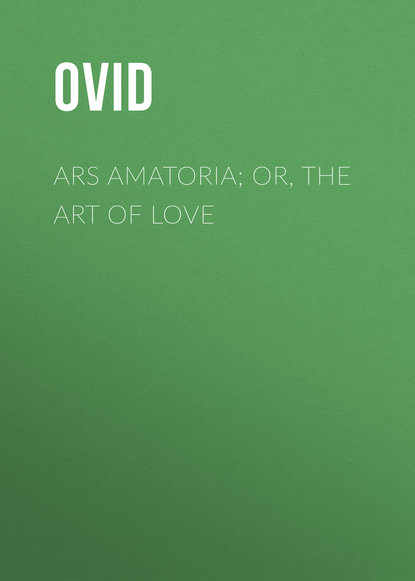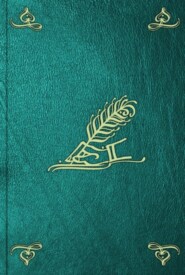По всем вопросам обращайтесь на: info@litportal.ru
(©) 2003-2024.
✖
Ars Amatoria; or, The Art Of Love
Настройки чтения
Размер шрифта
Высота строк
Поля
1014 (return (#x3_x_3_i6))
[ No door.—Ver. 71. So Horace says, in his address to Lydia, Book i. Ode i. 25; 'Less frequently do the wanton youths shake your joined windows with many a blow, and no longer deprive thee of sleep, and the door adheres to its threshold.']
1015 (return (#x3_x_3_i6))
[ Bestrewed with roses.—Ver. 72. See line 528: in the last Book Lucretius speaks of the admirers of damsels anointing their doors with M ointment made of sweet marjoram.]
1016 (return (#x3_x_3_i7))
[ Hermione.—Ver. 86. According to Hesiod, Venus was the mother of three children by Mars, of whom Hermione was one.]
1017 (return (#x3_x_3_i7))
[ May take up again.—Ver. 96. This is not the proper translation, of the passage; but the real meaning cannot be presented with a due regard to decorum.]
1018 (return (#x3_x_3_i8))
[ I begin with dress.—Ver. 101. He plays upon the different meanings of the word 'cultus'; which means either 'dress,' or 'cultivation,' according as it is applied, to persons or land.]
1019 (return (#x3_x_3_i8))
[ A great part.—Ver. 104. This is a more ungallant remark than we should have expected Ovid to make.]
1020 (return (#x3_x_3_i8))
[ Of Phoebus.—Ver. 119. He alludes to the temple of Apollo, on the Palatine Hill, where Augustus and Tiberius resided.]
1021 (return (#x3_x_3_i9))
[ And choice shells.—Ver. 124. He alludes to pearls which grow in the shell of the pearl oyster, and are found in the Persian Gulf and the Indian Ocean.]
1022 (return (#x3_x_3_i9))
[ By the moles.—Ver. 126. He alludes to the stupendous moles which the Romans fabricated, as breakwaters, at their various bathing-places on the coast of Italy. See the Odes of Horace, Book iii. ode 1.]
1023 (return (#x3_x_3_i10))
[ Round features.—Ver. 139. See the Pontic Epistles, Book iii Ep. iii. 1. 15, and the Note.]
1024 (return (#x3_x_3_i10))
[ Figure of the tortoise.—Ver. 147. Salmasius thinks that the 'galerus,' or 'wig of false hair,' is alluded to in this passage. Others think that a coif or fillet of net-work is alluded to. He probably means a mode of dressing the hair in the shape of a lyre, with horns on each side projecting outwards. Mercury, the inventor of the lyre, was born on Mount Cyllene, in Arcadia.]
1025 (return (#x3_x_3_i10))
[ The waves.—Ver. 148. Juvenal mentions a mode of dressing the hair to a great height by rows of false curls.]
1026 (return (#x3_x_3_i12))
[ The herbs from Germany.—Ver. 163. He alludes, probably, to herbs brought from Germany, which were burnt for the purpose of making a soap used in turning the hair of a blonde colour. See the Amores, Book i. El. xiv. 1. 1, and the Note.]
1027 (return (#x3_x_3_i12))
[ For money—Ver. 166. See 1. 45 of the above Elegy.]
1028 (return (#x3_x_3_i13))
[ The eyes of Hercules.—Ver. 168. He means that the wig-makers'shops were in the neighbourhood of the Temple of Hercules Musagetes, in the Flaminian Circus. See the Sixth Book of the Fasti, 1. 801.]
1029 (return (#x3_x_3_i14))
[ Gold flounces.—Ver. 169. 'Segmenta' are probably broad flounces to the dresses inlaid with plates of gold, or gold threads embroidered on them.]
1030 (return (#x3_x_3_i14))
[ On one's person.—Ver. 127. Like our expression, 'To carry a fortune on one's back.']
1031 (return (#x3_x_3_i14))
[ That art said.—Ver. 175. He refers to the colour of the Ram with the Golden Fleece, that bore Helle and Phryxus over the Hellespont.]
1032 (return (#x3_x_3_i14))
[ Resembles the waves.—Ver. 177. He evidently alluded to dresses which resemble the surface of the waves, and which we term 'watered'; and which the Romans called 'undulatae,' from 'unda,' a 'wave.' Varro makes mention of 'undulatæ togæ.' Some Commentators, however, fancy that he alludes here to colour, meaning 'glaucus,' or 'sea-green,' which Lucretius also calls ' thalassinus.']
1033 (return (#x3_x_3_i14))
[ Amaryllis.—Ver. 183. See the last Book, 1. 267, and the Note.]
1034 (return (#x3_x_3_i14))
[ And wax.—Ver. 184. Plautus mentions the 'Carinarii,' who dyed garments of a waxen, or yellow colour]
1035 (return (#x3_x_3_i16))
[ Seriphos.—Ver. 192. See the Metamorphoses, Book v. 1. 242, and the Note.]
1036 (return (#x3_x_3_i17))
[ Shocking goat.—Ver. 193. See the Note to 1. 522: of the First Book.]
1037 (return (#x3_x_3_i17))
[ Application of wax.—Ver. 199. Wax is certainly used as a cosmetic, but 'creta' seems to be a preferable reading, as chalk in a powdered state was much used for adding to the fairness of the complexion. Ovid would hardly recommend a cosmetic of so highly injurious a tendency as melted wax.]
1038 (return (#x3_x_3_i17))
[ The eye-brows.—Ver. 201. We learn from Juvenal, that the colour of them was heightened by punctures with a needle being filled with soot.]
[ No door.—Ver. 71. So Horace says, in his address to Lydia, Book i. Ode i. 25; 'Less frequently do the wanton youths shake your joined windows with many a blow, and no longer deprive thee of sleep, and the door adheres to its threshold.']
1015 (return (#x3_x_3_i6))
[ Bestrewed with roses.—Ver. 72. See line 528: in the last Book Lucretius speaks of the admirers of damsels anointing their doors with M ointment made of sweet marjoram.]
1016 (return (#x3_x_3_i7))
[ Hermione.—Ver. 86. According to Hesiod, Venus was the mother of three children by Mars, of whom Hermione was one.]
1017 (return (#x3_x_3_i7))
[ May take up again.—Ver. 96. This is not the proper translation, of the passage; but the real meaning cannot be presented with a due regard to decorum.]
1018 (return (#x3_x_3_i8))
[ I begin with dress.—Ver. 101. He plays upon the different meanings of the word 'cultus'; which means either 'dress,' or 'cultivation,' according as it is applied, to persons or land.]
1019 (return (#x3_x_3_i8))
[ A great part.—Ver. 104. This is a more ungallant remark than we should have expected Ovid to make.]
1020 (return (#x3_x_3_i8))
[ Of Phoebus.—Ver. 119. He alludes to the temple of Apollo, on the Palatine Hill, where Augustus and Tiberius resided.]
1021 (return (#x3_x_3_i9))
[ And choice shells.—Ver. 124. He alludes to pearls which grow in the shell of the pearl oyster, and are found in the Persian Gulf and the Indian Ocean.]
1022 (return (#x3_x_3_i9))
[ By the moles.—Ver. 126. He alludes to the stupendous moles which the Romans fabricated, as breakwaters, at their various bathing-places on the coast of Italy. See the Odes of Horace, Book iii. ode 1.]
1023 (return (#x3_x_3_i10))
[ Round features.—Ver. 139. See the Pontic Epistles, Book iii Ep. iii. 1. 15, and the Note.]
1024 (return (#x3_x_3_i10))
[ Figure of the tortoise.—Ver. 147. Salmasius thinks that the 'galerus,' or 'wig of false hair,' is alluded to in this passage. Others think that a coif or fillet of net-work is alluded to. He probably means a mode of dressing the hair in the shape of a lyre, with horns on each side projecting outwards. Mercury, the inventor of the lyre, was born on Mount Cyllene, in Arcadia.]
1025 (return (#x3_x_3_i10))
[ The waves.—Ver. 148. Juvenal mentions a mode of dressing the hair to a great height by rows of false curls.]
1026 (return (#x3_x_3_i12))
[ The herbs from Germany.—Ver. 163. He alludes, probably, to herbs brought from Germany, which were burnt for the purpose of making a soap used in turning the hair of a blonde colour. See the Amores, Book i. El. xiv. 1. 1, and the Note.]
1027 (return (#x3_x_3_i12))
[ For money—Ver. 166. See 1. 45 of the above Elegy.]
1028 (return (#x3_x_3_i13))
[ The eyes of Hercules.—Ver. 168. He means that the wig-makers'shops were in the neighbourhood of the Temple of Hercules Musagetes, in the Flaminian Circus. See the Sixth Book of the Fasti, 1. 801.]
1029 (return (#x3_x_3_i14))
[ Gold flounces.—Ver. 169. 'Segmenta' are probably broad flounces to the dresses inlaid with plates of gold, or gold threads embroidered on them.]
1030 (return (#x3_x_3_i14))
[ On one's person.—Ver. 127. Like our expression, 'To carry a fortune on one's back.']
1031 (return (#x3_x_3_i14))
[ That art said.—Ver. 175. He refers to the colour of the Ram with the Golden Fleece, that bore Helle and Phryxus over the Hellespont.]
1032 (return (#x3_x_3_i14))
[ Resembles the waves.—Ver. 177. He evidently alluded to dresses which resemble the surface of the waves, and which we term 'watered'; and which the Romans called 'undulatae,' from 'unda,' a 'wave.' Varro makes mention of 'undulatæ togæ.' Some Commentators, however, fancy that he alludes here to colour, meaning 'glaucus,' or 'sea-green,' which Lucretius also calls ' thalassinus.']
1033 (return (#x3_x_3_i14))
[ Amaryllis.—Ver. 183. See the last Book, 1. 267, and the Note.]
1034 (return (#x3_x_3_i14))
[ And wax.—Ver. 184. Plautus mentions the 'Carinarii,' who dyed garments of a waxen, or yellow colour]
1035 (return (#x3_x_3_i16))
[ Seriphos.—Ver. 192. See the Metamorphoses, Book v. 1. 242, and the Note.]
1036 (return (#x3_x_3_i17))
[ Shocking goat.—Ver. 193. See the Note to 1. 522: of the First Book.]
1037 (return (#x3_x_3_i17))
[ Application of wax.—Ver. 199. Wax is certainly used as a cosmetic, but 'creta' seems to be a preferable reading, as chalk in a powdered state was much used for adding to the fairness of the complexion. Ovid would hardly recommend a cosmetic of so highly injurious a tendency as melted wax.]
1038 (return (#x3_x_3_i17))
[ The eye-brows.—Ver. 201. We learn from Juvenal, that the colour of them was heightened by punctures with a needle being filled with soot.]














